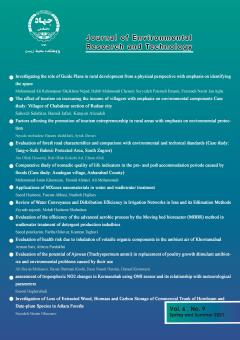Evaluation of the efficiency of the advanced aerobic process by the Moving bed bioreactor (MBBR) method in wastewater treatment of detergent production industries
Subject Areas : تکنولوژی آب و فاضلابsaeed poorkareem 1 , Fariba Ostovar 2 , Kamran Taghavi 3
1 - Responsible Expert in charge of disinfection systems and instantaneous measurement, Guilan Province Water and Wastewater Company, Guilan, Iran
2 - Faculty member of Environmental Institute, Academic Center for Education, Culture and Research, Guilan, Iran
3 - Assistant Professor, Environmental Health Engineering Group, University of Health, Guilan University of Medical Sciences
Keywords: Detergent, Alkyl benzene sulfonate liner, Fenton-like oxidation, MBBR, Detergent wastewater,
Abstract :
Abstract In this study, the aerobic biological process was investigated by the moving bed bioreactor (MBBR) method for wastewater treatment of detergent industries. The mean of COD and LAS in raw wastewater were 10231 mg/L and 210 mg/L, respectively. In this study, three different concentrations of LAS (210, 500, and 1000 mg/L) were used to determine the efficiency of the whole system in removing COD and LAS. The BOD5/COD ratio increased from 0.2 in raw wastewater to 0.45 after pretreatment. In the MBBR system in reactor 1 with 36 hours of hydraulic rate time (HRT), the highest removal efficiencies of 93.41% and 95% were obtained for COD and LAS, respectively. In Reactor 2 with similar conditions to HRT of 36 hours, the highest removal efficiencies for COD and LAS were 94.20% and 99.99%, respectively. By changing the amount of injected air from 30 L/min to 50 L/min and then 70 L/min, the removal efficiency in the amount of air injected about 50 L/min was increased. Organic charge loading (OUR) studies also showed a reduction in specific oxygen consumption from about 11 mg O2/gr MLSS.hr at the beginning of the operation period to about 2 mg O2/gr MLSS.hr at the end of the period. This study showed that the MBBR process, can meet the environmental output standards for the treatment of detergent industry wastewater and be used as an efficient method in detergent industry wastewater treatment.
